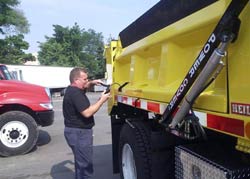Five Steps toward Optimizing a Fleet Preventive Maintenance Program

A solid preventive maintenance program can help vocational fleet managers keep vehicle repair costs and downtime to a minimum. An inefficient, poorly designed program can also cost time and money. Here are the areas that fleet managers should review in order to evaluate whether their preventive maintenance programs are optimized.
1. Analyze your fleet maintenance records. Are you tracking enough of the right information to make informed maintenance decisions? For example, simply recording that 'front end work' was completed on a vehicle does not give you enough information to detect failure trends for individual front end components. Your records should indicate at least the make and model of vehicle, date and mileage at time of service, and services performed to specific components. But remember, all the records in the world won't do a thing for you if you don't analyze the data.
2. Examine any unexplained incidents of demand maintenance that were required between scheduled preventive maintenance intervals. Look for trends. If a number of particular failures occur on certain vehicles, determine if it is possible to adjust your preventive maintenance program to eliminate those failures in the future. Some vehicles will be more prone to problems with certain systems than others. You may need to develop a different preventive maintenance schedule for certain makes and models of vehicles in the fleet or for those operating in specific applications. Remember, one generic preventive maintenance program may not work equally well for all fleets, or even for all vehicles within a particular fleet.
3. A good measure of the efficiency of your preventive maintenance program is the number of 'touches' technicians have on a vehicle. For example, you may have a vehicle scheduled for preventive maintenance three times a year, but find that it was actually pulled in for service six times -- the three scheduled services, plus another three times for various other services such as government-required safety and emissions inspections. Proper scheduling would have enabled these inspections to have been handled at the same time as the preventive maintenance. Every time a technician touches a vehicle, it costs you money and represents possible downtime. On average, every vehicle 'touch' takes a minimum of an hour of labor. Proper planning can minimize these costs.
 4. Determine whether you could be doing a better job of predictive maintenance. Use your records to calculate your fleet's average service life for various components, so you know when to proactively replace them. For example, say you find that Brand X alternators on Brand Y vehicles fail at around 85,000 miles on average. Your preventive maintenance schedule calls for 8,000-mile service intervals. Your service schedule, then, should include an alternator replacement as part of the first preventive maintenance service after 77,000 miles.
4. Determine whether you could be doing a better job of predictive maintenance. Use your records to calculate your fleet's average service life for various components, so you know when to proactively replace them. For example, say you find that Brand X alternators on Brand Y vehicles fail at around 85,000 miles on average. Your preventive maintenance schedule calls for 8,000-mile service intervals. Your service schedule, then, should include an alternator replacement as part of the first preventive maintenance service after 77,000 miles.
5. Keep in mind it is possible to set preventive maintenance intervals too close together. Intervals should be based on the type of vehicle application, usage (mileage, hours, operating environment, etc.), OEM warranty requirements and regulatory requirements. Far too many companies have one preventive maintenance schedule. But what's right for one vehicle may be too much for another vehicle and not enough for a third.
There is no one magic number for every vehicle in your fleet. And, just because you've always done it doesn't mean you have to continue doing it. Start your review by going back to the manufacturer's recommendations for the type of service for which you are using the vehicle. If your preventive maintenance intervals for the vehicle are more frequent than the manufacturer recommends, try conducting a lubricant analysis, primarily of engine oil.
Also check to see how much residual lubricant is present in unsealed joints at each service visit. If the oil analysis shows the oil is still good, there is still plenty of lubricant in each joint, and you have a good failure history, you may want to consider extending the service interval by a month and checking the same factors again. It's a combination of science with trial and error.
|